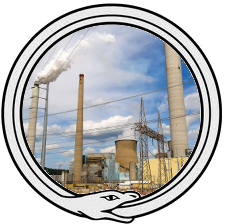
As the unacceptable results of continued fossil fuel combustion on climate change become ever clearer, a need to dramatically reduce greenhouse gas (GHG) emissions by aggressive energy conservation and immediate transitioning of global civilizations to alternative energy sources has become evident. Many energy technologies are capable replacing significant volumes of fossil fuels. Unfortunately, neither the enormous scale of the current fossil fuel energy system nor the necessary growth rate of these technologies is well understood within the limits imposed by the net energy produced for a growing industry.
This technical limitation is known as energy cannibalism and refers to an effect where rapid growth of an entire energy producing or energy efficiency industry creates a need for energy that uses (or cannibalizes) the energy of existing power plants or production plants.
Thus during rapid growth, the industry as a whole produces no net energy because new energy (or conserved energy) is used to fuel the embodied energy of future power plants or production facilities. Such life cycle analysis is also valid for GHG emissions. All current technologies are dependent to some degree on fossil fuel energy and thus also contribute to emissions.
Recent Work[edit | edit source]
Recent work expands earlier work to generalize the GHG emission neutral growth rate limitation imposed by energy cannibalism to any renewable energy technology or any energy efficiency technology.[1]
This has been formalized in an article: R. Kenny, C. Law, J.M. Pearce, "Towards Real Energy Economics: Energy Policy Driven by Life-Cycle Carbon Emission", Energy Policy 38, pp. 1969–1978, 2010. open access
Abstract[edit | edit source]
Alternative energy technologies (AETs) have emerged as a solution to the challenge of simultaneously meeting rising electricity demand while reducing carbon emissions. However, as all AETs are responsible for some greenhouse gas (GHG) emissions during their construction, carbon emission "Ponzi Schemes" are currently possible, wherein an AET industry expands so quickly that the GHG emissions prevented by a given technology are negated to fabricate the next wave of AET deployment. In an era where there are physical constraints to the GHG emissions the climate can sustain in the short term this may be unacceptable. To provide quantitative solutions to this problem, this paper introduces the concept of dynamic carbon life-cycle analyses, which generate carbon-neutral growth rates. These conceptual tools become increasingly important as the world transitions to a low-carbon economy by reducing fossil fuel combustion. In choosing this method of evaluation it was possible to focus uniquely on reducing carbon emissions to the recommended levels by outlining the most carbon-effective approach to climate change mitigation. The results of using dynamic life-cycle analysis provide policy makers with standardized information that will drive the optimization of electricity generation for effective climate change mitigation.
References[edit | edit source]
- ↑ Pearce, J.M. "Limitations of Greenhouse Gas Mitigation Technologies Set by Rapid Growth and Energy Cannibalism" Klima 2008, Available: Climate 2008 Paper
External links[edit | edit source]
Popular discussion[edit | edit source]
- Argument Over the Value of Solar Focuses on Spain - IEEE Spectrum